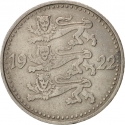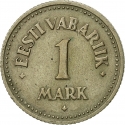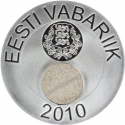You are about to finish your registration. Please check your mailbox (including spam folder). There should be a letter with a confirmation link. Check setting to make sure that your e-mail address is correct.
Send letter againDescription
Engraver: Georg Vestenberg
Obverse

|
Depicts the coat of arms of Estonia (1925–1940), the initials of the Estonian State Printing Office director Theodor Käärik (TK) on the bottom. TK |
|---|---|
Reverse

|
Depicts the denomination, while the country name (Estonian Republic) is positioned above it, and the issuing year date is located below. EESTI VABARIIK |
| Edge |
148 reeds |
Characteristics
| Material | Copper Zinc Nickel |
| Weight | 8.5 g |
| Diameter | 27.5 mm |
| Thickness | - |
| Shape |
|
| Alignment | Medal |
| Mint |
Estonian State Printing Office
|







